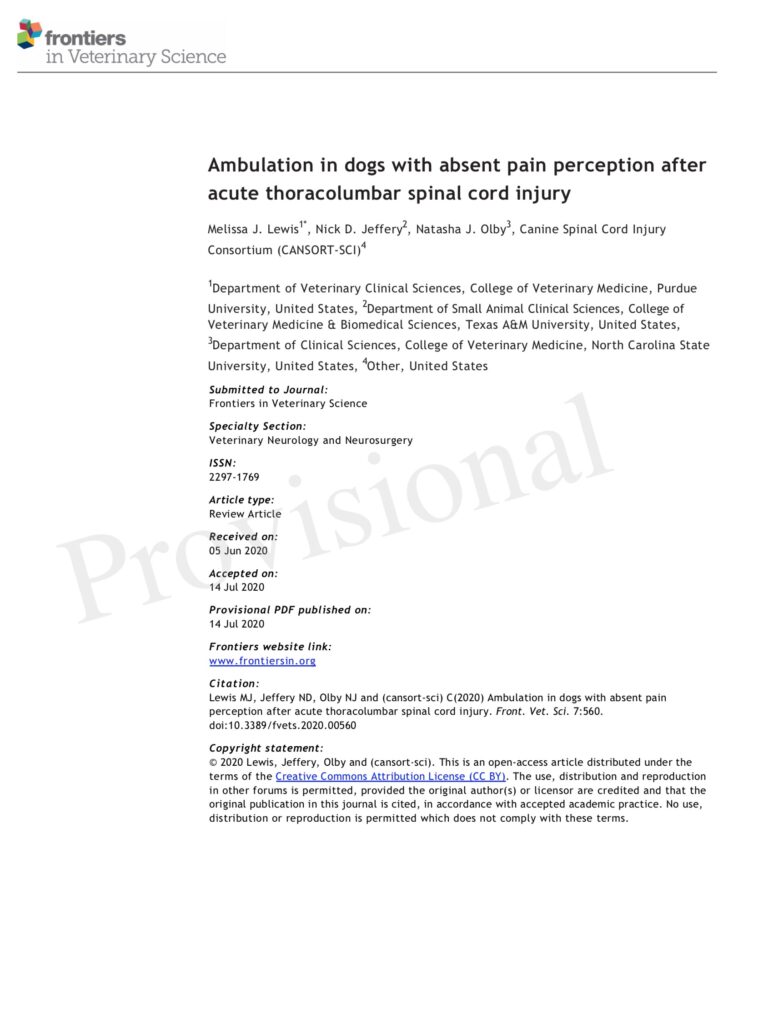Effets analgésiques de la médétomidine et de la dexmédétomidine – Hernie discale
DOULEUR CHEZ LES CHIENS ET CHATS
Effect of Medetomidine, Dexmedetomidine, and Their Reversal with Atipamezole on the Nociceptive Withdrawal Reflex in Beagles
(1) to compare the antinociceptive activity of dexmedetomidine and medetomidine
(2) to investigate its modulation by atipamezole.
This prospective, randomized, blinded experimental trial was carried out on eight beagles. During the first session, dogs received either medetomidine (MED) (0.02 mg kg−1 intravenously (IV)] or dexmedetomidine (DEX) [0.01 mg kg−1 IV), followed by either atipamezole (ATI) (0.1 mg kg−1) or an equivalent volume of saline (SAL) administered intramuscularly 45 min later. The opposite treatments were administered in a second session 10–14 days later. The nociceptive withdrawal reflex (NWR) threshold was determined using a continuous tracking approach. Sedation was scored (0 to 21) every 10 min. Both drugs (MED and DEX) increased the NWR thresholds significantly up to 5.0 (3.7–5.9) and 4.4 (3.9–4.8) times the baseline (p = 0.547), at seven (3–11) and six (4–9) minutes (p = 0.938), respectively.
Sedation scores were not different between MED and DEX during the first 45 min (15 (12–17), p = 0.67). Atipamezole antagonized sedation within 25 (15–25) minutes (p = 0.008) and antinociception within five (3–6) minutes (p = 0.008). Following atipamezole, additional analgesics may be needed to maintain pain relief.
Medetomidine, an alpha-2 agonist routinely used to provide sedation and pain relief in dogs, is a mixture of dexmedetomidine and levomedetomidine in equal proportions.
Dexmedetomidine, considered to be the only active component in the mixture, is also marketed alone. Sedation caused by both formulations can be reversed using atipamezole, which shortens recovery.
Dexmedetomidine provides analgesic effects similar to medetomidine, but it remains unclear at which dose and whether the analgesic effects of medetomidine or dexmedetomidine disappear once atipamezole is injected.
The present trial aimed at elucidating these uncertainties using the nociceptive withdrawal reflex model. This model allows for quantification of analgesia by measuring specific activity from muscles involved in limb withdrawal in response to mild electrical stimulation. In eight beagles, the model was applied to compare the extent of pain relief provided by medetomidine and dexmedetomidine and to investigate whether complete reversal occurs after the administration of atipamezole.
No difference in analgesic efficacy was identified between the two formulations. Both sedation and pain relief terminated rapidly when atipamezole was administered.
These findings indicate that medetomidine and dexmedetomidine provide comparable levels of pain relief and that additional analgesics may be necessary when atipamezole is administered to dogs experiencing pain.

DOULEUR CHEZ LES CHIENS ET CHATS
Résumé :
Acute thoracolumbar spinal cord injury (SCI) is common in dogs frequently secondary to intervertebral disc herniation. Following severe injury, some dogs never regain sensory function to the pelvic limbs or tail and are designated chronically ‘deep pain negative.’ Despite this, a subset of these dogs develop spontaneous motor recovery over time including some that recover sufficient function in their pelvic limbs to walk independently without assistance or weight support. This type of ambulation is commonly known as ‘spinal walking’ and can take up to a year or more to develop.
This review provides a comparative overview of locomotion and explores the physiology of locomotor recovery after severe SCI in dogs. We discuss the mechanisms by which post-injury plasticity and coordination between circuitry contained within the spinal cord, peripheral sensory feedback, and residual or recovered supraspinal connections might combine to underpin spinal walking. The clinical characteristics of spinal walking are outlined including what is known about the role of patient or injury features such as lesion location, timeframe post-injury, body size and spasticity. The relationship between the emergence of spinal walking and electrodiagnostic and magnetic resonance imaging findings are also discussed.
Finally, we review possible ways to predict or facilitate recovery of walking in chronically deep pain negative dogs. Improved understanding of the mechanisms of gait generation and plasticity of the surviving tissue after injury might pave the way for further treatment options and enhanced outcomes in severely injured dogs.





